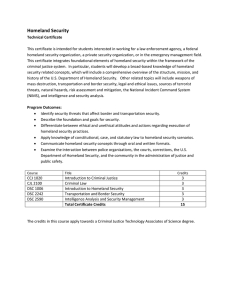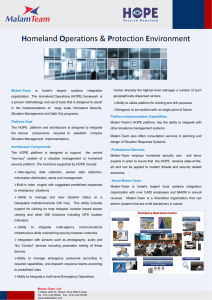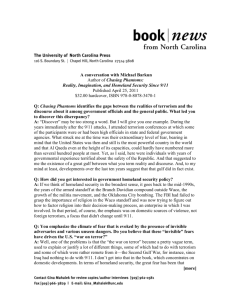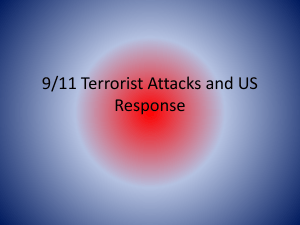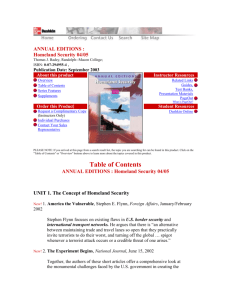Report - Tiffin University
advertisement
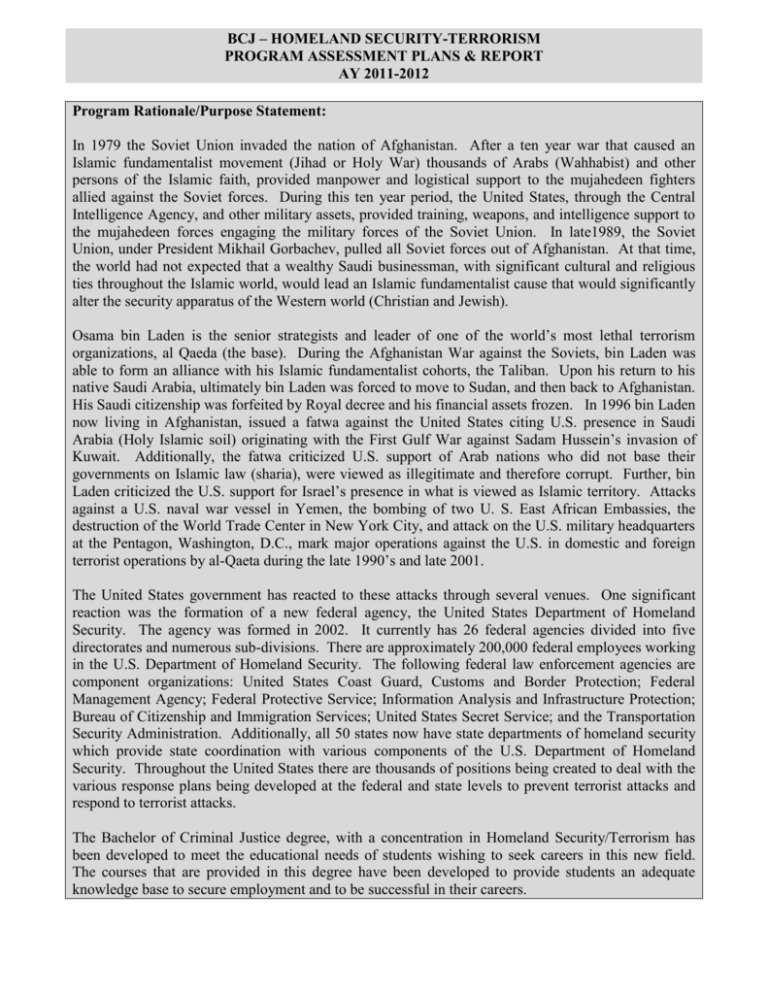
BCJ – HOMELAND SECURITY-TERRORISM PROGRAM ASSESSMENT PLANS & REPORT AY 2011-2012 Program Rationale/Purpose Statement: In 1979 the Soviet Union invaded the nation of Afghanistan. After a ten year war that caused an Islamic fundamentalist movement (Jihad or Holy War) thousands of Arabs (Wahhabist) and other persons of the Islamic faith, provided manpower and logistical support to the mujahedeen fighters allied against the Soviet forces. During this ten year period, the United States, through the Central Intelligence Agency, and other military assets, provided training, weapons, and intelligence support to the mujahedeen forces engaging the military forces of the Soviet Union. In late1989, the Soviet Union, under President Mikhail Gorbachev, pulled all Soviet forces out of Afghanistan. At that time, the world had not expected that a wealthy Saudi businessman, with significant cultural and religious ties throughout the Islamic world, would lead an Islamic fundamentalist cause that would significantly alter the security apparatus of the Western world (Christian and Jewish). Osama bin Laden is the senior strategists and leader of one of the world’s most lethal terrorism organizations, al Qaeda (the base). During the Afghanistan War against the Soviets, bin Laden was able to form an alliance with his Islamic fundamentalist cohorts, the Taliban. Upon his return to his native Saudi Arabia, ultimately bin Laden was forced to move to Sudan, and then back to Afghanistan. His Saudi citizenship was forfeited by Royal decree and his financial assets frozen. In 1996 bin Laden now living in Afghanistan, issued a fatwa against the United States citing U.S. presence in Saudi Arabia (Holy Islamic soil) originating with the First Gulf War against Sadam Hussein’s invasion of Kuwait. Additionally, the fatwa criticized U.S. support of Arab nations who did not base their governments on Islamic law (sharia), were viewed as illegitimate and therefore corrupt. Further, bin Laden criticized the U.S. support for Israel’s presence in what is viewed as Islamic territory. Attacks against a U.S. naval war vessel in Yemen, the bombing of two U. S. East African Embassies, the destruction of the World Trade Center in New York City, and attack on the U.S. military headquarters at the Pentagon, Washington, D.C., mark major operations against the U.S. in domestic and foreign terrorist operations by al-Qaeta during the late 1990’s and late 2001. The United States government has reacted to these attacks through several venues. One significant reaction was the formation of a new federal agency, the United States Department of Homeland Security. The agency was formed in 2002. It currently has 26 federal agencies divided into five directorates and numerous sub-divisions. There are approximately 200,000 federal employees working in the U.S. Department of Homeland Security. The following federal law enforcement agencies are component organizations: United States Coast Guard, Customs and Border Protection; Federal Management Agency; Federal Protective Service; Information Analysis and Infrastructure Protection; Bureau of Citizenship and Immigration Services; United States Secret Service; and the Transportation Security Administration. Additionally, all 50 states now have state departments of homeland security which provide state coordination with various components of the U.S. Department of Homeland Security. Throughout the United States there are thousands of positions being created to deal with the various response plans being developed at the federal and state levels to prevent terrorist attacks and respond to terrorist attacks. The Bachelor of Criminal Justice degree, with a concentration in Homeland Security/Terrorism has been developed to meet the educational needs of students wishing to seek careers in this new field. The courses that are provided in this degree have been developed to provide students an adequate knowledge base to secure employment and to be successful in their careers. Marketing / Recruitment Target Statement: Tiffin University, School of Criminal Justice and Social Services has developed a curriculum that will provide students knowledge of the U. S. criminal justice system, knowledge of terrorist organizations and operational methodologies, intelligence process, and basic research skills. The specific students this program targets are those students who are wanting to gain a career in the federal or state public safety forces, in positions that are involved with the security of the United States against foreign and domestic terrorist attacks. Information gained in these courses will also provide students with knowledge that can applied in the various local law enforcement agencies. Program Learning Outcomes: Goals of the Program/Corresponding Classes: 1./ Develop critical thinking and analytical skills of students as they apply to research and practical application of knowledge. JUS461 / SCS300/470 / ENF450 Describe the history of terrorism and intelligence in domestic and foreign national security operations. NSS341 / ENF441 Identify the factors influencing multi-jurisdictional emergency responses to domestic and foreign terrorist operations. ENF343/345 To be able to devise problem-solving strategies regarding the tools of homeland security, their use in a political/legal context, and the underlying homeland security policies further or altered by their use. NSS312/341 / JUS 215 / ENF344/441/450 Program Executive Summary: Section One: Describe all department activities with respect to improving student learning in the major. This may include new faculty hires, course revisions, assignment creation, rubric revisions, goal evaluations, etc. Section Two: Describe which program goal(s) in the Major Program Plan was assessed during the academic year. Section Three: Describe analysis of assessment data and action plans for upcoming academic year. Intended Outcomes/Assessment Criteria: Intended Outcomes 1: (D – Critical Thinking / D – Career Readiness – Program Specific) Students will develop their critical thinking and analytical skills through courses which enable them to do academic and criminal justice research, participate in practicum’s, and participate in discussions with criminal justice professionals. Assessment Criteria: Seventy percent of students will have a “75%” or better grade on final quiz/exam that requires critical thinking and analytical skills as they apply to research and application of knowledge: SCS300/470 / JUS461 / ENF450. Section One - Activity Statement: STUDENTS WERE ADMINISTERED A FINAL EXAM IN SCS300, JUS 461, AND ENF 450. Section Two - Results of Outcomes Activity: 2011-2012 Met/Not Met Data Details MET/NOT 100% EXCEEDED CRITERION IN SCS300 AND ENF45096% MET. EXCEEDED THE CRITERION IN JUS 461. 100% EXCEEDED THE CRITERION IN ENF 450. Section Three - Analysis and Action Plans: New plans will be designed during the 2012 fall semester with direct consultation from the director of outcomes assessment, The director has been working in-depth with one school each year and this coming year it will be with the School of Criminal Justice and Social Sciences. Intended Outcomes 2: (D – Career Readiness – Program Specific) Students will have gained the ability to describe the history of terrorism, the purpose of domestic and foreign intelligence, and the operability of intelligence in conducting domestic and foreign national security operations. Assessment Criteria: Seventy percent of students will have a “75%” or better grade on final quiz/exam that describes the history of terrorism, and domestic and foreign national security operations: ENF312/343/ENF441. Section One - Activity Statement: Examinations covering the topics listed were administered in the listed classes. Section Two - Results of Outcomes Activity: 2011-2012 Met/Not Met Data Details MET 70% of the students enrolled in ENF312 & 343 met or exceeded the criteria. 80% of the students in ENF441 met or exceeded the criteria Section Three - Analysis and Action Plans: New plans will be designed during the 2012 fall semester with direct consultation from the director of outcomes assessment, The director has been working in-depth with one school each year and this coming year it will be with the School of Criminal Justice and Social Sciences. Intended Outcomes 3: (D – Career Readiness – Program Specific) Students will be able to identify factors which influence multi-jurisdictional and emergency responses to domestic and foreign terrorist operations. Assessment Criteria: Seventy percent of students will have a “75%” or better grade on final quiz/exam that identifies factors influencing jurisdictional emergency responses to domestic and foreign terrorist operations: ENF343/345. Section One - Activity Statement: FINAL EXAM GIVEN IN ENF345. Section Two - Results of Outcomes Activity: 2011-2012 Met/Not Met Data Details MET. 100% OF THE STUDENTS ENROLLED SCORED 85% OR HIGHER ON THE FINAL EXAM. Section Three - Analysis and Action Plans: New plans will be designed during the 2012 fall semester with direct consultation from the director of outcomes assessment, The director has been working in-depth with one school each year and this coming year it will be with the School of Criminal Justice and Social Sciences. Intended Outcomes 4: (D – Critical Thinking / D – Career Readiness – Program Specific) To be able to devise problem-solving strategies regarding the tools of homeland security, their use in a political/legal context, and the underlying homeland security policies further or altered by their use. Assessment Criteria: Activity within course(s) to measure goal: (provide activity details): final quiz/exam designed to measure the following: Seventy percent of students will demonstrate, to a 3 level in the Rubric Rating Scale, a sufficient knowledge of past use of the instruments of national power, in their political/legal and policy context, to analyze problems in homeland security. Seventy percent of students will demonstrate, to a 3 level in the Rubric Rating Scale, a sufficient understanding of the instruments themselves, and of the enabling or limiting effects of political/legal and policy contexts, to devise reasonable and effective solutions to homeland security problems. NSS312/341 / JUS215 / ENF344/441/450 Section One - Activity Statement: To be able to devise problem-solving strategies regarding the tools of homeland security, their use in a political/legal context, and the underlying homeland security policies further or altered by their use. JUS 215 & ENF450 WERE THE COURSES SELECTED FOR MEASUREMENT. Section Two - Results of Outcomes Activity: 2011-2012 Met/Not Met Data Details MET/NOT 90% EXCEEDED THE CRITERION IN MET EXCEEDED THE CRITERION IN ENF450. JUS215. 100% Section Three - Analysis and Action Plans: New plans will be designed during the 2012 fall semester with direct consultation from the director of outcomes assessment, The director has been working in-depth with one school each year and this coming year it will be with the School of Criminal Justice and Social Sciences. Updated: September 2012


